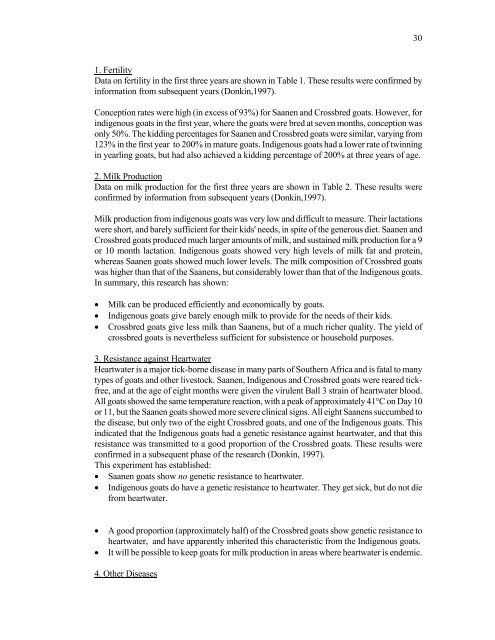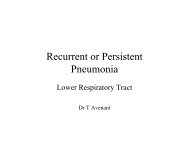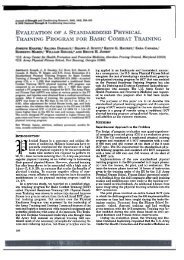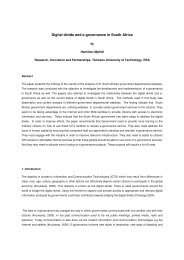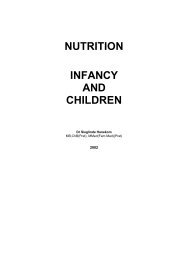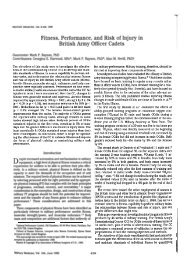Research and Training Strategies for Goat Production Systems in ...
Research and Training Strategies for Goat Production Systems in ...
Research and Training Strategies for Goat Production Systems in ...
Create successful ePaper yourself
Turn your PDF publications into a flip-book with our unique Google optimized e-Paper software.
1. Fertility<br />
Data on fertility <strong>in</strong> the first three years are shown <strong>in</strong> Table 1. These results were confirmed by<br />
<strong>in</strong><strong>for</strong>mation from subsequent years (Donk<strong>in</strong>,1997).<br />
Conception rates were high (<strong>in</strong> excess of 93%) <strong>for</strong> Saanen <strong>and</strong> Crossbred goats. However, <strong>for</strong><br />
<strong>in</strong>digenous goats <strong>in</strong> the first year, where the goats were bred at seven months, conception was<br />
only 50%. The kidd<strong>in</strong>g percentages <strong>for</strong> Saanen <strong>and</strong> Crossbred goats were similar, vary<strong>in</strong>g from<br />
123% <strong>in</strong> the first year to 200% <strong>in</strong> mature goats. Indigenous goats had a lower rate of tw<strong>in</strong>n<strong>in</strong>g<br />
<strong>in</strong> yearl<strong>in</strong>g goats, but had also achieved a kidd<strong>in</strong>g percentage of 200% at three years of age.<br />
2. Milk <strong>Production</strong><br />
Data on milk production <strong>for</strong> the first three years are shown <strong>in</strong> Table 2. These results were<br />
confirmed by <strong>in</strong><strong>for</strong>mation from subsequent years (Donk<strong>in</strong>,1997).<br />
Milk production from <strong>in</strong>digenous goats was very low <strong>and</strong> difficult to measure. Their lactations<br />
were short, <strong>and</strong> barely sufficient <strong>for</strong> their kids' needs, <strong>in</strong> spite of the generous diet. Saanen <strong>and</strong><br />
Crossbred goats produced much larger amounts of milk, <strong>and</strong> susta<strong>in</strong>ed milk production <strong>for</strong> a 9<br />
or 10 month lactation. Indigenous goats showed very high levels of milk fat <strong>and</strong> prote<strong>in</strong>,<br />
whereas Saanen goats showed much lower levels. The milk composition of Crossbred goats<br />
was higher than that of the Saanens, but considerably lower than that of the Indigenous goats.<br />
In summary, this research has shown:<br />
• Milk can be produced efficiently <strong>and</strong> economically by goats.<br />
• Indigenous goats give barely enough milk to provide <strong>for</strong> the needs of their kids.<br />
• Crossbred goats give less milk than Saanens, but of a much richer quality. The yield of<br />
crossbred goats is nevertheless sufficient <strong>for</strong> subsistence or household purposes.<br />
3. Resistance aga<strong>in</strong>st Heartwater<br />
Heartwater is a major tick-borne disease <strong>in</strong> many parts of Southern Africa <strong>and</strong> is fatal to many<br />
types of goats <strong>and</strong> other livestock. Saanen, Indigenous <strong>and</strong> Crossbred goats were reared tickfree,<br />
<strong>and</strong> at the age of eight months were given the virulent Ball 3 stra<strong>in</strong> of heartwater blood.<br />
All goats showed the same temperature reaction, with a peak of approximately 41°C on Day 10<br />
or 11, but the Saanen goats showed more severe cl<strong>in</strong>ical signs. All eight Saanens succumbed to<br />
the disease, but only two of the eight Crossbred goats, <strong>and</strong> one of the Indigenous goats. This<br />
<strong>in</strong>dicated that the Indigenous goats had a genetic resistance aga<strong>in</strong>st heartwater, <strong>and</strong> that this<br />
resistance was transmitted to a good proportion of the Crossbred goats. These results were<br />
confirmed <strong>in</strong> a subsequent phase of the research (Donk<strong>in</strong>, 1997).<br />
This experiment has established:<br />
• Saanen goats show no genetic resistance to heartwater.<br />
• Indigenous goats do have a genetic resistance to heartwater. They get sick, but do not die<br />
from heartwater.<br />
• A good proportion (approximately half) of the Crossbred goats show genetic resistance to<br />
heartwater, <strong>and</strong> have apparently <strong>in</strong>herited this characteristic from the Indigenous goats.<br />
• It will be possible to keep goats <strong>for</strong> milk production <strong>in</strong> areas where heartwater is endemic.<br />
4. Other Diseases<br />
30


